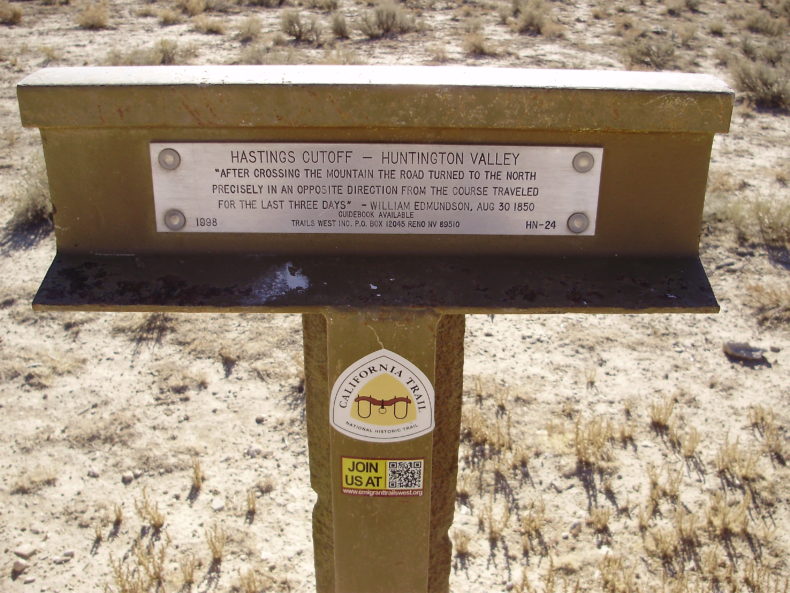A couple weeks ago, we were driving through Wyoming when I saw a sign for the Oregon Trail Cutoff. At this point we’d been in the car for something like four hours, and blessedly we were on some stretch of highway with reception, so I googled it. The cutoff, I learned, was the Lander Trail, a wagon road built with funds from the U.S. government in the late 1850s. My search brought up other deviations from the Oregon Trail: the Mormon Trail, the Bozeman Trail, the Sublette-Greenwood Cutoff, Hudspeth’s Cutoff. The one that caught my eye was called the Hastings Cutoff, “used by the ill-fated Donner Party,” according to Wikipedia.
If you already happen to know anything beyond the basics of either historical topic, you might skip this post. But as someone woefully ignorant about both — my knowledge of the Oregon Trail is limited to the landmarks and demands of the computer game, and I knew only that the Donner Party became cannibals — I was surprised about how much of the story I’d never heard before.
You can, of course, read the wikipedia entries yourselves, but here’s a cliff’s notes from memory: the Donner Party was made up of several families traveling to California. The two major families traveling were the the Reeds and the Donners; James Reed, the patriarch of the Reed family, was an Irish immigrant, and he was not popular with the group. George Donner, on the other hand, was “American-born,” and generally liked. (Wikipedia says nothing about the political context here, but one can’t help but wonder whether these men’s backgrounds might have played a role in shaping what others thought of them.)
The path to California began on the Oregon Trail; in Idaho, the California Trail veered south while the Oregon Trail continued north. The Donner Party began their journey west from Independence, Kansas on May 12. Exactly two months later, they received a letter from a man named Lansford Hastings. He claimed he’d found a more direct path to California; whereas the Oregon trail doglegged between what’s now Wyoming and Idaho, Hastings’ Cutoff (which he of course named after himself) cut through the Wasatch Mountains and the Great Salt Lake. The letter was one of many Hastings had sent to travelers along the Oregon trail; he’d hired riders to travel on horseback to intercept emigrants and encourage them to take the Hastings route. The letter Reed and Donner received said that Hastings would be waiting for them at Fort Bridger, Wyoming, where he’d lead them along his great new trail.
But when they arrived at Fort Bridger, Hastings had already left. A man named Jim Bridger encouraged them to take the cutoff anyway, saying it’d be a “smooth trip” with plenty of water. At least two other people tried to warn the group NOT to take the shortcut: Reed ran into a friend who told him not to take the cutoff, and a journalist, who was a few weeks ahead of the Donner party on cutoff, sent a letter to them telling them to avoid the path, but the group never received his warning.
Reed was all for taking the “shortcut,” so the group went. It turned out to be a longcut, miles longer than the more established trail to California, and required traveling through the steep eastern edge of the Wasatch range as well as a long slog through the Great Salt Lake. The group moved extremely slowly through the punishing terrain, some of their cattle and oxen escaped or died, and James Reed even killed a guy and was banished from the group. Eventually, the group got stranded at Donner Pass over the winter. You’ve probably know the basic outline of the result: as their food stores dwindled and people died, some of the survivors began to eat the corpses. What I didn’t know was that there were multiple rescue missions, and one survivor, after returning to civilization, died by breaking into food stores and eating himself to death. Absolutely brutal.
I’ve always known their story was tragic, but what I didn’t realize was how much of their plight was the result of being swindled by self-interested con-men. Hastings hadn’t actually traveled his own cutoff before he started hyping it up; he was just eager to make a name for himself. Bridgers, the guy who encouraged the group to take the Hastings cutoff, had a trading post along that route and wanted more people to take the cutoff so he could get more business. Dozens of people died in large part because of the cutoff, and yet this part of the story is rarely talked about! While I’ve heard plenty of Donner party-related cannibalism quips, never once had I learned about the greed for money and fame underlying their fate.
I’ll leave you with another wormhole to fall into: Lansford Hastings went on to join the Confederate Army, and he was promoted to Major when he pitched Jefferson Davis a half-baked plan to make California leave the union and join the confederacy. Obviously, that didn’t happen, so Hastings moved to Brazil; he and fellow confederate expats, now known as the Confederados, moved there to colonize Brazil and set up a cotton industry to rival the U.S.’s.
